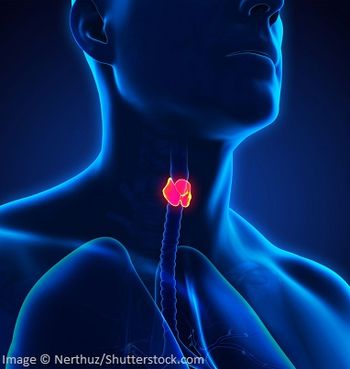
- ONCOLOGY Vol 13 No 7
- Volume 13
- Issue 7
Carcinoma of the Thyroid
Carcinoma of the Thyroid is the first edition of a text dedicated to the anatomy, physiology, diagnosis, and treatment of thyroid malignancy. The book is written in a fairly uniform format, with 17 chapters contributed either by one of the editors or
Carcinoma of the Thyroid is the first edition of a text dedicated to the anatomy, physiology, diagnosis, and treatment of thyroid malignancy. The book is written in a fairly uniform format, with 17 chapters contributed either by one of the editors or by a number of contributing authors. The book is short at only 134 pages and is generally written in a clear, concise format with liberal use of over 125 excellent color diagrams in addition to many lucid tables.
The first four chapters provide a clear, well-illustrated synopsis of the applied embryology, anatomy, physiology, and pathology of the thyroid and its malignancies. I found the figures relating to the embryology and anatomy of the thyroid gland to be particularly helpful. The color photographs of gross and histologic sections of thyroid tumors and their descriptions are better than are found in any other text in this field.
The next section of the book, which deals with the assessment of the thyroid using ultrasonography, computed tomography (CT), magnetic resonance imaging (MRI), and fine-needle aspiration is generally clear and well written. Unfortunately, because of its concise format, this section provides little data to support the use of the various modalities and offers little guidance on when they need to be used.
A chapter on surgery for thyroglossal duct remnants follows. It is clear, concise, and extremely well illustrated.
Subsequent chapters on surgery of the thyroid gland, lymphadenectomy, and extended surgical procedures are well written and illustrated from a technical point of view but provide no discussion and little data on the relative merits of total thyroidectomy vs hemithyroidectomy for thyroid malignancy. There is a paucity of discussion regarding the long-term outcome of surgical therapy for thyroid malignancy. In addition, the chapter on lymphadenectomy does not include available data on lymphadenectomy for the treatment of recurrent medullary thyroid carcinoma.
A chapter on the use of radioiodine follows the surgical chapters. While clearly written, it fails to address long-term outcome measures relative to the use of radioactive iodine.
The book ends with an excellent, well-referenced chapter on external-beam radiation therapy for thyroid cancer and a short discussion of chemotherapy for thyroid cancer.
Notwithstanding the significant limitations associated with writing a comprehensive but short text on a variety of malignancies of the thyroid gland, Carcinoma of the Thyroid is a clear, concise, well-illustrated introduction that should be helpful to students, residents, and clinicians who treat thyroid malignancies.
Articles in this issue
over 26 years ago
Discussing Disease Progression and End-of-Life Decisionsover 26 years ago
New Genetic Mechanism Associated With Thyroid-Related Diseasesover 26 years ago
Beyond 5-Fluorouracilover 26 years ago
Nonsurgical Therapy Holds Promise for Basal Cell Carcinomaover 26 years ago
Photodynamic Therapy Effective for Swallowing Problemsover 26 years ago
Novel Gene Therapy to Clear Blood Clots in Leg ArteriesNewsletter
Stay up to date on recent advances in the multidisciplinary approach to cancer.

















































































